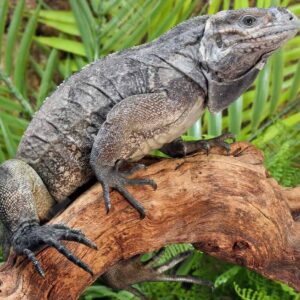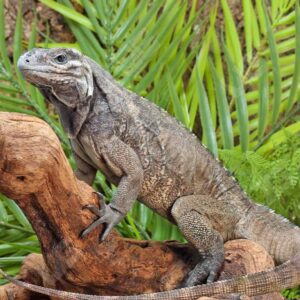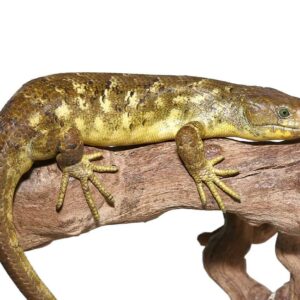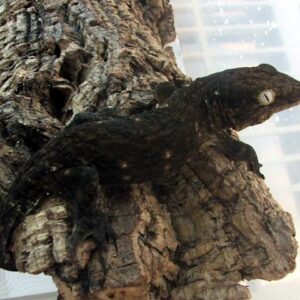Yearling Hypo Green Iguana For Sale
$999.99
WE HAVE HYPO GREEN IGUANA FOR SALE. HERE ARE SOME HIGHLIGHTS:
- Iguana iguana
- Captive Bred
- Approximately 3-4 Feet In Length From Head To Tail
- Healthy And Thriving
- Feeding On Mixed Vegetables And Canned Iguana Food
- Originating From South Mexico To South America And The Caribbean
- With Good Care And Handling These Iguanas Can Live Up To 15-20 Years
- Adults Can Get Up To Massive Sizes Around 5-6 Feet In Length
- These Lizards Are Used To Living In The Trees So Make Sure To Include Lots Of Branches,
- They Also Enjoy A Water Dish Large Enough To Soak In
Description
Hypo Green Iguana
The Hypo Green Iguana, scientifically known as Iguana iguana, is a unique and fascinating reptile that captures the attention of both herpetology enthusiasts and exotic pet owners alike. This iguana is distinguished by its vivid green coloration, which is lighter and more vibrant compared to other iguana species. This distinctive hue is a result of hypomelanism, a genetic condition that reduces melanin production, giving the Hypo Green Iguana its characteristic bright appearance.
In addition to its striking color, the Hypo Green Iguana possesses a robust and elongated body, typically measuring between four to six feet in length when fully grown. Their physical structure includes a row of spines along their back and tail, a dewlap under the chin, and a pronounced jawline. The visual appeal of this iguana is further enhanced by its large, expressive eyes, which provide a keen sense of vision, essential for their survival in the wild.
Understanding the Hypo Green Iguana is crucial for several reasons. For hobbyists and breeders, comprehending the genetic traits and care requirements of this iguana can lead to healthier and more vibrant specimens. For potential pet owners, knowledge about the specific needs and behaviors of the Hypo Green Iguana can ensure a better quality of life for the animal and a more rewarding experience for the owner. Unlike standard green iguanas, Hypo Green Iguanas may require more specialized care, particularly in terms of lighting, diet, and habitat setup to maintain their unique coloration and overall health.
By delving into the specifics of the Hypo Green Iguana, this guide aims to provide a comprehensive understanding that benefits both seasoned herpetologists and new pet owners. This foundational knowledge sets the stage for more detailed discussions on care, habitat, diet, and health considerations that follow in subsequent sections.
The Hypo Green Iguana, a remarkable reptile known for its vibrant coloration, primarily inhabits tropical and subtropical regions. These iguanas are predominantly found in Central and South America, with notable populations in countries such as Mexico, Honduras, Nicaragua, Costa Rica, and Panama. Their distribution extends to the northern parts of South America, including Venezuela and Colombia.
These iguanas thrive in environments characterized by high humidity and warm temperatures, typically ranging between 80°F (27°C) and 95°F (35°C). Rainforests, riverbanks, and coastal areas with abundant vegetation are their preferred habitats, providing ample food sources and necessary cover from predators. The lush foliage of these regions offers Hypo Green Iguanas the perfect setting for camouflage and protection, while also facilitating their arboreal lifestyle.
Climate plays a significant role in the distribution of Hypo Green Iguanas. They are adapted to climates with distinct wet and dry seasons, which influence their breeding and feeding behaviors. During the wet season, the abundance of food resources such as leaves, flowers, and fruits supports their dietary needs. Conversely, in the dry season, these iguanas exhibit adaptability by consuming tougher, fibrous plant material, which is more readily available.
However, habitat destruction poses a severe threat to the Hypo Green Iguana populations. Deforestation, driven by agricultural expansion, urbanization, and logging activities, has led to the fragmentation of their natural habitats. This fragmentation not only reduces the available living space for these iguanas but also isolates populations, making it challenging for them to find mates and maintain genetic diversity.
Climate change further exacerbates these challenges by altering the environmental conditions of their habitats. Increased temperatures, altered precipitation patterns, and extreme weather events disrupt the delicate balance of their ecosystems. As a result, Hypo Green Iguanas may face difficulties in adapting to rapidly changing conditions, leading to potential declines in their populations.
Efforts to conserve the Hypo Green Iguana and their habitats are crucial to ensure their survival. Conservation strategies include protecting critical habitats, promoting sustainable land-use practices, and raising awareness about the impacts of climate change and habitat destruction. By understanding and addressing these challenges, we can contribute to the preservation of this unique and vibrant species.
Physical Characteristics and Color Variations
The Hypo Green Iguana, a captivating variant of the common Green Iguana, exhibits distinct physical characteristics that set it apart from its counterparts. Adult Hypo Green Iguanas typically reach lengths of 4 to 6 feet, with males being larger than females. Their average weight ranges between 10 to 20 pounds, depending on factors such as diet and habitat conditions. These iguanas possess a robust build, with strong limbs and a well-muscled tail, which they use for balance and defense.
A defining feature of the Hypo Green Iguana is its unique coloration. Hypo, short for hypomelanistic, refers to a genetic mutation that reduces the amount of melanin in the skin. This results in a lighter, more vibrant green hue compared to the darker tones seen in standard Green Iguanas. The reduced melanin also gives Hypo Green Iguanas a slightly translucent appearance, especially noticeable in the early stages of their development.
Another notable physical trait is the presence of a row of spines along the back, extending from the neck to the tail. These spines, combined with their large, dewlapped throat, contribute to their impressive and somewhat intimidating appearance. The eyes of the Hypo Green Iguana are equipped with excellent vision, critical for detecting predators and locating food sources. Additionally, their sharp, serrated teeth are adapted for a herbivorous diet, primarily consisting of leafy greens and fruits.
It is important to highlight the genetic basis for their distinctive color variation. The hypomelanistic trait is a recessive gene, meaning both parent iguanas must carry the gene to produce hypo offspring. This genetic distinction places the Hypo Green Iguana among the more sought-after morphs within the reptile enthusiast community. The vibrant, lighter coloration not only makes them visually striking but also provides a unique contrast when compared to other iguana morphs, such as the Albino or Blue Iguanas.
Behavior and Social Structure
Hypo Green Iguanas display a range of behaviors that reflect their adaptation to both wild and captive environments. In their natural habitat, these iguanas are primarily arboreal, spending a significant amount of time in the trees. This behavior helps them avoid ground predators and allows easier access to their diet of leaves, fruits, and flowers. In captivity, providing climbing structures mimics their natural environment, helping to reduce stress and encourage natural behaviors.
Social interactions among Hypo Green Iguanas are complex and often involve a clear hierarchy, particularly in the wild. Dominance is typically established through physical displays and, occasionally, minor skirmishes. Males are more territorial than females and will often engage in head bobbing, dewlap extension, and body posturing to assert dominance and control over a specific area. In captivity, it is advisable to house these iguanas individually or in carefully monitored groups to prevent aggressive encounters.
Activity patterns of Hypo Green Iguanas are diurnal, meaning they are most active during the day. Early mornings and late afternoons are peak times for foraging and basking. Basking is a crucial behavior for these ectothermic reptiles as it allows them to regulate their body temperature and digest their food efficiently. Providing a basking spot with appropriate temperature gradients is essential in captivity to ensure their well-being.
Foraging behavior in Hypo Green Iguanas involves searching for food sources both in the trees and on the ground. They exhibit a preference for a variety of plant materials, which should be replicated in captivity to meet their dietary needs. Additionally, territorial displays are common, particularly during the breeding season, where males become more aggressive in defending their territory and attracting females.
Understanding the behavior and social structure of Hypo Green Iguanas is vital for their proper care and management, both in the wild and in captivity. By recognizing their natural behaviors and social needs, caretakers can create an environment that promotes their health and well-being.
Diet and Nutrition
The diet and nutritional needs of Hypo Green Iguanas are critical to their overall health and well-being. In the wild, these iguanas primarily consume a variety of leaves, flowers, and fruits. Their diet is largely herbivorous, with a strong preference for plant-based foods that provide essential nutrients. In captivity, replicating this diet as closely as possible is crucial for their health.
Leafy greens should form the cornerstone of a Hypo Green Iguana’s diet. Optimal choices include collard greens, mustard greens, and turnip greens, all of which are rich in calcium and other vital nutrients. Additionally, vegetables such as bell peppers, squash, and carrots can be included to diversify their intake and provide essential vitamins and minerals.
Fruits should be offered sparingly, as they are high in sugar. Suitable fruits include mango, papaya, and strawberries. While these can be a tasty treat, they should not constitute more than 10-15% of the iguana’s overall diet. Overconsumption of fruits can lead to health issues such as obesity and metabolic bone disease.
Protein sources, though not a primary component of their diet, can be beneficial in small amounts. Occasional feeding of plant-based proteins such as legumes and tofu can help meet their protein requirements without the risks associated with animal-based proteins, which can be harmful to iguanas.
Dietary supplements are often necessary to ensure that Hypo Green Iguanas receive all the nutrients they need. Calcium supplements, in particular, are essential to prevent deficiencies that can lead to metabolic bone disease. A high-quality reptile multivitamin can also be beneficial when used as directed.
Feeding schedules should be consistent, with young iguanas fed daily and adults every other day. Fresh water should always be available to keep them hydrated. By understanding and meeting the dietary needs of Hypo Green Iguanas, caregivers can contribute significantly to their pets’ long-term health and vitality.
Housing and Environmental Needs
Properly housing a Hypo Green Iguana is crucial for its health and well-being. The enclosure size is a fundamental aspect to consider; adult Hypo Green Iguanas require a spacious environment. Ideally, the enclosure should be at least 8 feet long, 4 feet wide, and 6 feet tall to accommodate their growth and active nature. For juveniles, a smaller, yet adequately sized enclosure can be used initially, but keep in mind the need to upgrade as they grow.
Substrate selection plays a significant role in maintaining a clean and healthy habitat. Suitable substrates include newspaper, reptile carpet, or orchid bark. These materials are easy to clean and reduce the risk of impaction, a common issue with loose substrates like sand or gravel. Regular cleaning and substrate replacement help in maintaining a hygienic environment.
Temperature regulation is another critical factor for Hypo Green Iguanas. The enclosure should have a temperature gradient, with a basking area maintained between 90-100°F and a cooler side around 75-85°F. Nighttime temperatures should not drop below 70°F. To achieve this, use heat lamps or ceramic heat emitters, and always monitor temperatures with reliable thermometers.
Maintaining appropriate humidity levels is essential for the Hypo Green Iguana’s health, aiming for a range of 70-80%. This can be achieved through regular misting, using a humidifier, and incorporating a large water dish within the enclosure. Proper humidity supports skin shedding and overall respiratory health.
UVB lighting is indispensable for Hypo Green Iguanas, as it facilitates the synthesis of vitamin D3, crucial for calcium absorption and bone health. A high-quality UVB bulb should be provided, with a photoperiod of 10-12 hours daily. Ensure the bulb is replaced every six months, even if it still emits visible light, as UVB output diminishes over time.
Lastly, enriching the enclosure with climbing structures and hiding spots mimics the iguana’s natural environment, promoting physical activity and reducing stress. Branches, vines, and platforms encourage climbing, while hiding spots offer security. These elements are vital for the mental and physical well-being of the Hypo Green Iguana, contributing to a thriving captive environment.
Health and Common Diseases
Maintaining the health of Hypo Green Iguanas is paramount for their longevity and well-being. Recognizing signs of good health is the first step in ensuring your iguana thrives. A healthy Hypo Green Iguana typically exhibits bright, clear eyes, smooth skin without lesions, and a robust appetite. Regular, active behavior and a well-formed stool are also indicators of good health.
However, Hypo Green Iguanas are susceptible to several common health issues. Metabolic Bone Disease (MBD) is prevalent, often resulting from inadequate calcium levels or insufficient UVB lighting. Symptoms include swollen limbs, soft jawbones, and lethargy. Respiratory infections are another frequent concern, usually caused by improper humidity or temperature levels. Signs include wheezing, nasal discharge, and open-mouth breathing.
To prevent these and other diseases, it’s critical to provide a balanced diet and appropriate environment. A diet rich in leafy greens, vegetables, and occasional fruits, supplemented with calcium and vitamins, supports overall health. Ensuring a habitat with optimal temperatures, humidity, and UVB lighting is equally important.
Routine health checks play a vital role in early disease detection. Regularly examine your Hypo Green Iguana for any physical changes, abnormal behaviors, or signs of illness. If any symptoms of disease are observed, seeking veterinary care promptly is crucial. An experienced reptile veterinarian can offer a definitive diagnosis and treatment plan tailored to your iguana’s needs.
Preventative measures, such as maintaining a clean habitat, providing a nutritious diet, and regular health assessments, are essential. By diligently monitoring their health and environment, you can significantly reduce the risk of diseases and ensure your Hypo Green Iguana leads a healthy, vibrant life.
Breeding and Lifespan
The breeding habits of Hypo Green Iguanas are both fascinating and intricate, contributing significantly to their lifecycle. During the breeding season, which typically occurs in the dry months, males exhibit a range of courtship behaviors to attract females. These behaviors include head bobbing, body posturing, and vibrant display of their dewlap. The courtship period is crucial, as it ensures the selection of the fittest mates, promoting healthy offspring.
Once the female Hypo Green Iguana has been successfully courted, the mating process follows. Post-mating, the female will enter a gravid state, during which she carries the developing eggs. Approximately 65 to 75 days after mating, the female will seek a suitable nesting site to lay her eggs. Nesting sites are typically sandy or loose soil areas, where the female can dig a burrow to deposit her eggs safely. A typical clutch can contain anywhere from 20 to 70 eggs, depending on the female’s size and health.
After laying the eggs, the incubation period begins, lasting around 90 to 120 days. The temperature and humidity levels during incubation are critical, as they influence the hatching success and the sex of the hatchlings. In controlled environments such as captivity, these conditions can be carefully monitored and adjusted to ensure optimal hatching rates.
The lifespan of Hypo Green Iguanas varies significantly between wild and captive environments. In the wild, these iguanas face numerous threats, including predators, habitat destruction, and environmental changes, which can limit their lifespan to approximately 10 to 15 years. Conversely, in captivity, where they are provided with proper care, nutrition, and a controlled environment, Hypo Green Iguanas can live much longer, often reaching 20 years or more.
Several factors influence the longevity of Hypo Green Iguanas, including genetics, diet, habitat conditions, and healthcare. Providing a balanced diet rich in leafy greens, proper UVB lighting, and regular veterinary check-ups can significantly enhance their lifespan. Understanding these factors is essential for anyone looking to breed or care for Hypo Green Iguanas effectively.









